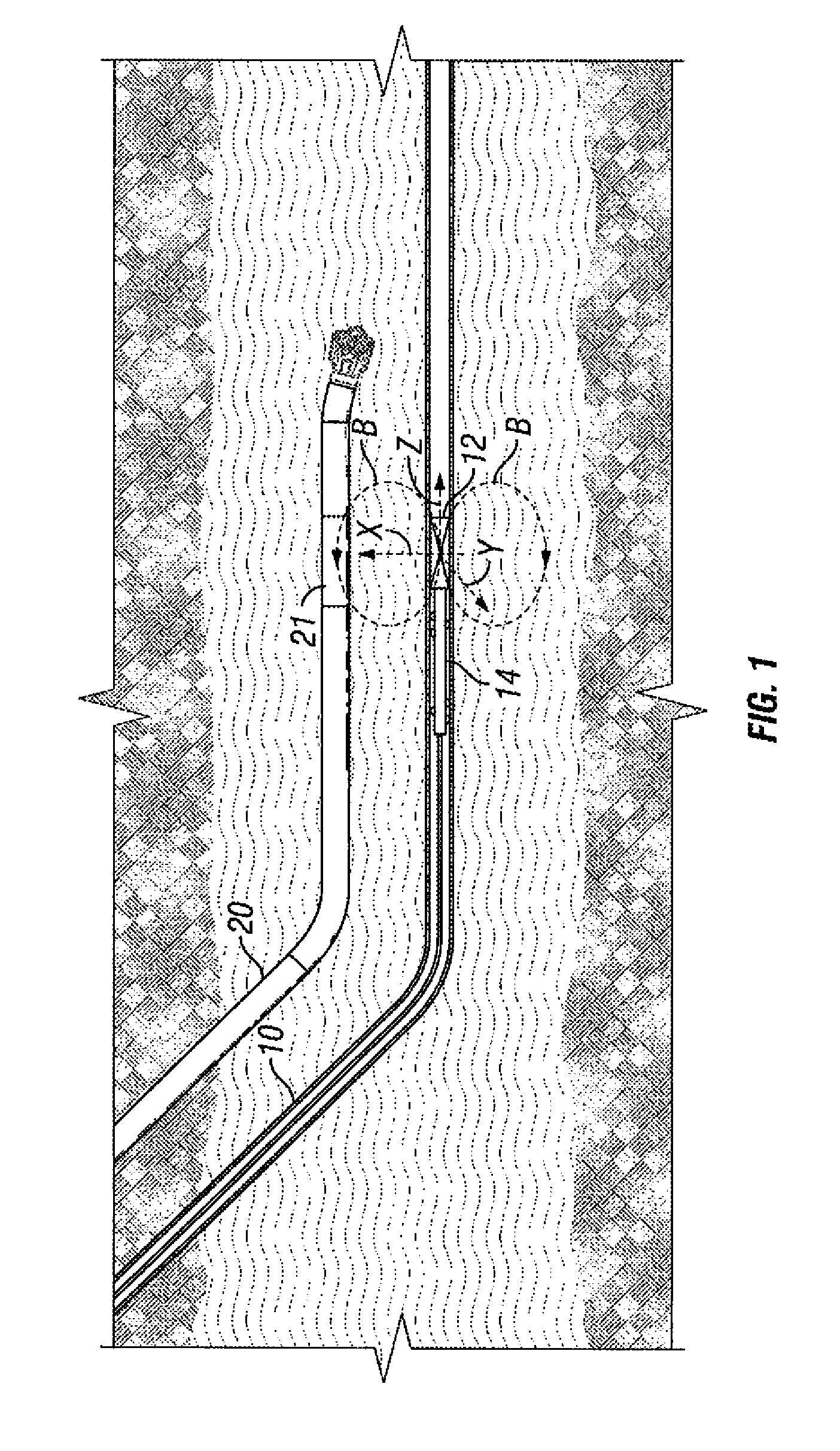Magnetic ranging and controlled earth borehole drilling
a controlled earth and magnetic field technology, applied in the direction of borehole/well accessories, instruments, surveys, etc., can solve the problems of time-consuming, inability to compute the distance to the first well, and introduce errors in the calculated distance between the two wells, so as to reduce the amount of rig time, reduce the strength of the magnetic field, and high and variable magnetic permeability
- Summary
- Abstract
- Description
- Claims
- Application Information
AI Technical Summary
Benefits of technology
Problems solved by technology
Method used
Image
Examples
example # 1
EXAMPLE #1
SAGD Wells at 5 m Separation
[0068]In this example, the two solenoids are separated by a distance d=10 m and each solenoid has a magnetic dipole moment of M=100 amp-meter2. A SAGD injector well is to be drilled 5 m above the producer well. It is assumed that the MWD magnetometer is located at (x3,y3,z3)=(5 m,1 m,z3), various quantities are plotted as a function of z3. The magnetic field components measured at the magnetometer (B1r, B1z, B2r, and B2z) are shown in FIG. 7. Noise with a standard deviation of 0.1 nTesla noise has been added to field components: B1x, B1y, B1z, B2x, B2y, and B2z. Note that the magnetic field is strongest over the range z3=−5 m to z3=+15 m. In FIGS. 8 to 11, the axial position of the MWD magnetometer (z3) is incremented in 1 m steps while inverting for r, x3, y3, and z3, respectively. The average results and standard deviations are also tabulated in Table 1 for two ranges: z3 ε[0.5 m,9.5 m] and z3 ε[−5.5 m,15.5 m]. The difference between the inver...
example # 2
EXAMPLE #2
SAGD Wells at 10 m Separation
[0069]In this example, the two solenoids are again separated by a distance d=10 m and each solenoid has a magnetic dipole moment of M=100 amp-meter2. A SAGD injector well is to be drilled 10 m above the producer well. It is assumed that the MWD magnetometer is located at (x3,y3,z3)=(10 m,1 m,z3), various quantities are plotted as a function of z3. The magnetic field components measured at the magnetometer are shown in FIG. 12. Noise with a standard deviation of 0.1 nTesla noise has been added to all field components. In FIGS. 13 to 16, the axial position of the MWD magnetometer (z3) is varied in 1 m steps while inverting for r, x3, y3, and z3, respectively. The average results and standard deviations are also tabulated in Table 2 for two ranges: z3 ε[0.5 m,9.5 m] and z3 ε[−5.5 m,15.5 m]. The results are still good for 0≦z3≦d, and still quite useful for −5≦z3≦d+5.
TABLE 2Inverted parameters for example #2. The average value and thestandard deviat...
example # 3
EXAMPLE #3
SAGD Wells at 15 m Separation
[0070]In this case, it is advantageous to separate the two solenoids to d=15 m and to increase the magnetic dipole moment to M=200 amp-meter2. It is assumed that the MWD magnetometer is located at (x3,y3,z3)=(15 m,1 m,z3), and various quantities are plotted as a function of z3. The magnetic field components measured at the magnetometer are shown in FIG. 17. Noise with a standard deviation of 0.1 nTesla noise has been added to all field components. In FIGS. 18 to 21, the axial position of the MWD magnetometer (z3) is varied in 1 m steps while inverting for r, x3, y3, and z3, respectively. The average results and standard deviations are also tabulated in Table 3 for two ranges: z3 ε[0.5 m,14.5 m] and z3 ε[−5.5 m,20.5 m]. The results provide an accuracy better than 1 m in all conditions, even with a potential uncertainty in z3 of ±13 m.
TABLE 3Inverted parameters for example #3. The average value and thestandard deviation are given for each range o...
PUM
 Login to View More
Login to View More Abstract
Description
Claims
Application Information
 Login to View More
Login to View More - R&D
- Intellectual Property
- Life Sciences
- Materials
- Tech Scout
- Unparalleled Data Quality
- Higher Quality Content
- 60% Fewer Hallucinations
Browse by: Latest US Patents, China's latest patents, Technical Efficacy Thesaurus, Application Domain, Technology Topic, Popular Technical Reports.
© 2025 PatSnap. All rights reserved.Legal|Privacy policy|Modern Slavery Act Transparency Statement|Sitemap|About US| Contact US: help@patsnap.com



